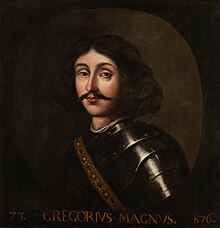Giric
| Giric | |
|---|---|
| Král Piktů | |
 | |
| Doba vlády | 878–889 |
| Úplné jméno | Giric mac Dúngail |
| Narození | 9. století |
| Úmrtí | 890 |
| Pohřben | Iona |
| Předchůdce | Aedh |
| Nástupce | Donald II. |
| Otec | Donald I. |
| Některá data mohou pocházet z datové položky. | |
Giric, vlastním jménem Giric mac Dúngail, byl králem Piktů asi v letech 878–889. Ani Irské letopisy, ani Anglosaská kronika neuvádějí žádné informace o jeho vládě a skromné informace, které o ní existují, jsou protichůdné. Moderní historici se neshodují, zda Giric vládl samostatně nebo společně s Eochaidem a zda má být považován za krále Piktů nebo již za prvního panovníka království Alba.
Zdroje informací o panovnících království Alba jsou v období po rozsáhlém vpádu vikingů v letech 875 až 876 zmatené. Následníci krále Piktů Kennetha I. ztratili vládu nad královstvím někdy v období let 878 až 889. V tomto období zde vládl Eochaid nebo Giric. Ten mohl být Eochaidův strážce.
Reference
V tomto článku byl použit překlad textu z článku Giric mac Dúngail na anglické Wikipedii.
Externí odkazy
 Obrázky, zvuky či videa k tématu Giric na Wikimedia Commons
Obrázky, zvuky či videa k tématu Giric na Wikimedia Commons
Média použitá na této stránce
The painting is depicted within a painted oval, facing the front, wearing armour, with a jewelled sash across his right shoulder. This portrait is one of ninety-three bust-lengths commissioned to decorate the Great Gallery at Holyroodhouse, Edinburgh. It is painted by Jacob de Wet II, a Dutch artist working in Scotland from 1673. Together with eighteen full-lengths these portraits illustrate the genealogy of the royal house of Scotland from Fergus I (who ascended the throne in 330 BC) to James VII (who abdicated in 1689). De Wet’s iconographic scheme was based on well-known chronicles of Scottish history by the Renaissance humanists Hector Boece (Scotorum Historiae, 1527) and George Buchanan (Rerum Scoticarum Historia, 1582). The inscriptions on the paintings correspond with Buchanan’s list of Scottish kings: from left to right, these are the number and name of the king followed by the date of accession. The dates however are considerably muddled, by a later restorer or perhaps even the artist himself. Both real and legendary, their purpose was to proclaim the authority of the Stuarts as divinely appointed rulers of Scotland. Commissioned and paid for by the Scottish Privy Council, the series was intended to convey the power and greatness of the country’s governing body as much as that of their king. With no authentic likenesses on which to base his portraits of medieval kings, de Wet made extensive use of an earlier set by the Scottish artist George Jamesone, of which twenty-six survive in private collections. From this limited basis the resulting series appears rather repetitious. Much more important than their aesthetic merit therefore was the symbolic power of painting an extremely long royal lineage stretching more than two millennia. Buchanan, Rerum Scoticarum Historia (translation from 1751): ‘surnamed the Great, Son of Dongallus II … A Prince valiant, victorious, and renowned through the World in his Time. He died in Peace’. Number 73 in the series. Inscribed GREGORIVS.MAGNVS. 876.
Provenance
Commissioned by the Scottish Privy Council in the name of Charles II.
